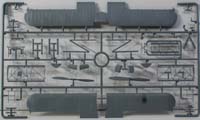
ICM 1/32 Stearman PT-17 Kaydet Kit First Look
By Michael Benolkin
| Date of Review | October 2020 | Manufacturer | ICM |
|---|---|---|---|
| Subject | Stearman PT-17 Kaydet | Scale | 1/32 |
| Kit Number | 32050 | Primary Media | Styrene |
| Pros | Nice details | Cons | See text |
| Skill Level | Experienced | MSRP (USD) | $64.99 |
First Look
 |
 |
 |
 |
The Stearman Model 75 was designed as a training aircraft that was adopted by the U.S. Army Air Corps, U.S. Navy, and the Royal Canadian Air Force to train new pilots as these countries entered World War 2. Over 10,600 examples were built before production ended. There is some confusion about the various designators for this aircraft, but all were based upon the same airframe. The PT-13 (USAAC) and the N2S-2/5 (USN) were powered by the Lycoming 9-cylinder radial engine. The PT-17 and N2S-1/4 were powered by the Continental 7-cylinder radial engine, while the PT-18 was powered by the Jacobs R-755 7-cylinder engine. All of the engines that powered the Model 75 in its different variants were rated at 220 horsepower. While Boeing acquired Stearman Aircraft in 1934, the aircraft was known as the Stearman in U.S. circles while the RCAF called the aircraft the Kaydet. When the aircraft entered civilian service after the war, one of the more popular upgrades, regardless of the variant, was to replace the aircraft's engine with the R-965 Wasp Jr. 9-cylinder radial engine rated at 300 hp and turning a constant-speed propeller.
About six months prior to this first-look, Roden released their 1/32 PT-17 kit and I grabbed two and tried to build one of them. Out of the box, the kit looked great, but once i tried to mount the wings onto the fuselage, their promising kit turned out to be lacking in basic engineering and the project set aside. I have since seen others attempt and fail to get that kit to the finish line. That's when I learned that ICM was going to do this subject in 1/32 as well, so I waited (somewhat) patiently. This time I bought one kit to see how it goes before doing any more. As when I started the Roden(t) kit, I planned to do the U.S. Navy N2S-3 'Yellow Peril' and the USAAC blue/yellow schemes.
This kit is a simple layout and consists of five parts trees molded in gray styrene plus one tree of clear parts. The molding is sharp with nice details inside the cockpits and around the airframe. Among the features and options in this kit:
- Nicely detailed Continental engine
- Choice of fixed-pitch (wood) or adjustable pitch propellers
- Nicely detailed cockpits
- Nice surface detail on the instrument panels and instrument faces provided as decals
- Positionable elevators
- Positionable rudder
- Positionable ailerons
- Nice design for fool-proof gear struts
- Kit 32050 is the basic PT-17 kit while this release is really 32051 which includes three standing WASP figures
The decal sheet provides marking options for three aircraft:
- PT-17, 41-8582, 10, 63rd AAF Flight Training Det., Douglas Field, GA, 1942
- PT-17, 41-25714, 12, WASP Flight Training School, Avenger Field, CA, 1943
- N2S-3, 39123, USN, 1944
A few notes to consider:
- The instructions provide a basic rigging illustration, but there are many good online resources for these details in more depth
- The engine does not have an ignition harness so you're on your own
- The painting instructions are laid out using only Revell and Tamiya color references but I have no idea where they got their color recommendations. See the color section below
- The tubular frame around the cockpit is more delicate than the Roden(t) version and many of the frame parts come pre-broken. Given the petite diameter of the frame, I don't think glue is going to help, but given that the cockpit layout and installation is virtually identical to the Roden(t) kit, I may rob the frame structure out of that kit
- The assembly of the fuselage, right down to the landing gear is nearly identical to the Rodent(t) kit. The engine design is different (not better)
- The key question is whether the wing struts will work. Unlike the Roden(t) kit, the interplane struts have good mounts on both wings, while the cabane struts have good mounts on the upper wing while bottoms of the cabane struts look like they will get glued wherever they land on the fuselage.
While this kit looks as nice in most aspects as the Roden(t) kit, and much better with the wing struts, we'll see how this one goes together soon enough. After the disappointing results of the Roden(t) kit, I am going to be skeptical until this bird is built successfully.
Here is a list of paints representing the ANA colors used by the Stearman:
ANA 501
B220
C220
ANA 506
H329
B066
C066
ANA 512
XA1138
ANA 611
H058
N058
B211
C211
A007
XA1117
H008
N008
B003
C003
36190
LP11
X11
ICM has done a great job with this kit and they can offer other variants of the Stearman by simply swapping out engines. You don't have to wait for that to happen as there are resin engines in the aftermarket that will allow you to render just about any variant, wartime or postwar, you might wish to build. I wound up purchasing two, one to build as the PT-17, the other as an N2S, but I'm still undecided whether to swap engines as described in the introduction.







